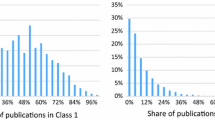Abstract
In this paper, we model the variation of the bibliometric measure differences across academic fields in order to quantify the sources of these discrepancies. Since the bibliometric measure is based on the amount of published and cited papers, we anticipate that the mean number of references by published paper is the predominant parameter behind the discrepancies of impact factor scores in some academic fields. We introduce here a bias-free model, based on normalized variables with restricted cross-discipline discrepancies, that is robust against fraud and scams. The model is then submitted to an intensive numerical test using a Monte Carlo simulation.






Similar content being viewed by others
References
Bani-Ahmad, S. (2011). Sorting search results of literature digital libraries: Recent developments and future research directions. In Digital libraries-methods and applications (IntechOpen).
Banks, M. A. (2005). The excitement of google scholar, the worry of google print. Biomedical Digital Libraries, 2(1), 2.
Bordons, M., Fernández, M., & Gómez, I. (2002). Advantages and limitations in the use of impact factor measures for the assessment of research performance. Scientometrics, 53(2), 195–206.
Brun, R., & Rademakers, F. (1997). Root an object oriented data analysis framework. Nuclear Instruments and Methods in Physics Research Section A: Accelerators, Spectrometers, Detectors and Associated Equipment, 389(1–2), 81–86.
Dong, P., Loh, M., & Mondry, A. (2005). Relevance similarity: An alternative means to monitor information retrieval systems. Biomedical Digital Libraries, 2(1), 6.
Garfield, E. (1986). Which medical journals have the greatest impact? Annals of Internal Medicine, 105(2), 313–320.
Garfield, E. (1992). How isi [r] selects journal for coverage: Quantitative and qualitative considerations (institute for scientific information [r]). Journal de Radiologie-Paris, 73, 565–565.
Garfield, E. (1998). Long-term versus short-term journal impact: Does it matter. Scientist, 12(3), 11–12.
Garfield, E. (1999). Journal impact factor: A brief review. Ottawa: Can Med Assoc.
Garfield, E. (2003). The meaning of the impact factor. International Journal of Clinical and Health Psychology, 3(2), 363–369.
Garfield, E. (2006a). Citation indexes for science: A new dimension in documentation through association of ideas. International Journal of Epidemiology, 35(5), 1123–1127.
Garfield, E. (2006b). The history and meaning of the journal impact factor. JAMA, 295(1), 90–93.
Jacsó, P. (2001). A deficiency in the algorithm for calculating the impact factor of scholarly journals: The journal impact factor. Cortex, 37(4), 590–594.
Mabe, M. (2003). The growth and number of journals. Serials, 16(2), 191–198.
Mabe, M., & Amin, M. (2001). Growth dynamics of scholarly and scientific journals. Scientometrics, 51(1), 147–162.
Moed, H., Burger, W., Frankfort, J., & Van Raan, A. (1985). The application of bibliometric indicators: Important field-and time-dependent factors to be considered. Scientometrics, 8(3–4), 177–203.
Moed, H. F., Burger, W., Frankfort, J., & Van Raan, A. (1983). On the measurement of research performance: The use of bibliometric indicators. Leiden: State University of Leiden.
Møller, A. P. (1990). National citations. Nature, 348, 480.
Murali, N. S., Murali, H. R., Auethavekiat, P., Erwin, P. J., Mandrekar, J. N., Manek, N. J., & Ghosh, A. K. (2004). Impact of futon and NAA bias on visibility of research. In Mayo clinic proceedings (Vol. 79, pp. 1001–1006).
Narin, F., Pinski, G., & Gee, H. H. (1976). Structure of the biomedical literature. Journal of the American society for Information Science, 27(1), 25–45.
Seglen, P. O. (1997). Why the impact factor of journals should not be used for evaluating research. BMJ, 314(7079), 497.
van Leeuwen, T., & Moed, H. (2002). Development and application of journal impact measures in the dutch science system. Scientometrics, 53(2), 249–266.
Whitehouse, G. (2001). Citation rates and impact factors: Should they matter? The British Journal of Radiology, 74(877), 1–3.
Author information
Authors and Affiliations
Corresponding author
Rights and permissions
About this article
Cite this article
Belkadhi, K., Trabelsi, A. Toward a stochastically robust normalized impact factor against fraud and scams. Scientometrics 124, 1871–1884 (2020). https://doi.org/10.1007/s11192-020-03577-4
Received:
Published:
Issue Date:
DOI: https://doi.org/10.1007/s11192-020-03577-4



